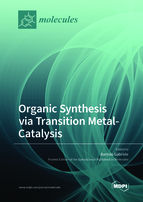Organic Synthesis via Transition Metal-Catalysis
A special issue of Molecules (ISSN 1420-3049). This special issue belongs to the section "Organic Chemistry".
Deadline for manuscript submissions: closed (31 December 2021) | Viewed by 25938
Special Issue Editor
Interests: new syntheses of high value added molecules through catalytic assembly of simple units; innovative syntheses of heterocyclic molecules of pharmaceutical; agrochemical; applicative interest; carbonylation chemistry; use of non-conventional solvents in organic synthesis; synthesis and semi-synthesis of bioactive compounds of pharmaceutical or agrochemical interest; synthesis of new materials for advanced applications; extraction; characterization; evaluation of the biological activity of bioactive principles from natural matrices
Special Issues, Collections and Topics in MDPI journals
Special Issue Information
Dear Colleagues,
This Special Issue is devoted to the development of novel organic syntheses using transition metal complexes as catalysts. Transition metal catalysis is one of the most important and active areas in the field of modern organic synthesis, as it may allow the preparation of complex, multifunctionalized molecules in one step via the assembly of simple building blocks through an ordered sequence of mechanistic steps promoted by the metal center. The importance of this chemistry is continuously growing, and its huge synthetic impact will continue to attract the interest of scientists, both in academia and industry around the world.
Prof. Dr. Bartolo Gabriele
Guest Editor
Manuscript Submission Information
Manuscripts should be submitted online at www.mdpi.com by registering and logging in to this website. Once you are registered, click here to go to the submission form. Manuscripts can be submitted until the deadline. All submissions that pass pre-check are peer-reviewed. Accepted papers will be published continuously in the journal (as soon as accepted) and will be listed together on the special issue website. Research articles, review articles as well as short communications are invited. For planned papers, a title and short abstract (about 100 words) can be sent to the Editorial Office for announcement on this website.
Submitted manuscripts should not have been published previously, nor be under consideration for publication elsewhere (except conference proceedings papers). All manuscripts are thoroughly refereed through a single-blind peer-review process. A guide for authors and other relevant information for submission of manuscripts is available on the Instructions for Authors page. Molecules is an international peer-reviewed open access semimonthly journal published by MDPI.
Please visit the Instructions for Authors page before submitting a manuscript. The Article Processing Charge (APC) for publication in this open access journal is 2700 CHF (Swiss Francs). Submitted papers should be well formatted and use good English. Authors may use MDPI's English editing service prior to publication or during author revisions.
Keywords
- catalysis
- heterogeneous catalysis
- homogeneous catalysis
- metal-catalyzed reactions
- organic synthesis promoted by metal catalysts







